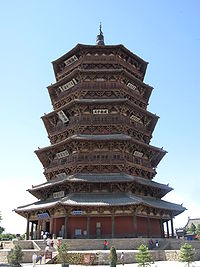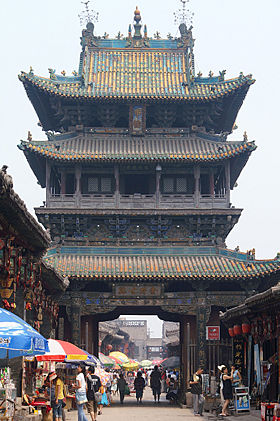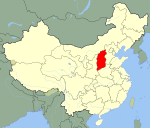- Shanxi
-
Coordinates: 37°42′N 112°24′E / 37.7°N 112.4°E
Shanxi Province Chinese : 山西省 Shānxī Shěng Abbreviations: simplified Chinese: 晋; traditional Chinese: 晉 (pinyin: Jìn) 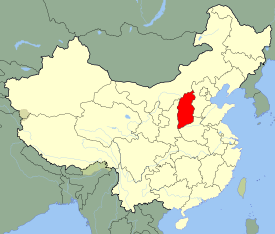
Origin of name 山 shān - mountain
西 xī - west
"west of the Taihang Mountains"Administration type Province Capital
(and largest city)Taiyuan CPC Ctte Secretary Yuan Chunqing Governor Wang Jun Area 156,800 km2 (60,500 sq mi) (19th) - Latitude 34° 35' to 40° 44' N - Longitude 110° 13' to 114° 33' E Population (2010)
- Density35,712,111 (18th)
213 /km2 (550 /sq mi) (19th)GDP (2010)
- per capitaCNY 908.8 billion (US$134.2 billion) (21st)
CNY 21,544 (17th)HDI (2008) 0.800 (high) (14th) Ethnic composition Han - 99.7%
Hui - 0.2%Spoken dialects {{{Dialects}}} Prefectural level 11 divisions County level 119 divisions Township level* 1388 divisions ISO 3166-2 CN-14 Official website
www.shanxigov.cn (Chinese)Source for population and GDP data: Source for nationalities data: *As at December 31, 2004 Template ■ Discussion ■ WikiProject China  Shanxi (help·info) (Chinese: 山西; pinyin: Shānxī; Wade–Giles: Shan-hsi; Postal map spelling: Shansi) is a province in Northern China. Its one-character abbreviation is "晋" (pinyin: Jìn), after the state of Jin that existed here during the Spring and Autumn Period.
Shanxi (help·info) (Chinese: 山西; pinyin: Shānxī; Wade–Giles: Shan-hsi; Postal map spelling: Shansi) is a province in Northern China. Its one-character abbreviation is "晋" (pinyin: Jìn), after the state of Jin that existed here during the Spring and Autumn Period.The name Shanxi literally means "mountain's west", which refers to the province's location west of the Taihang Mountains.[1] Shanxi borders Hebei to the east, Henan to the south, Shaanxi to the west, and Inner Mongolia to the north. The capital of the province is Taiyuan.
Contents
History
Shanxi, the territory of state of Jin during the Spring and Autumn Period (722 BC - 403 BC), underwent a three-way split into the states of Han, Zhao and Wei in 403 BC, the traditional date taken as the start of the Warring States Period (403 BC - 221 BC). By 221 BC all of these states had fallen to the state of Qin, which established the Qin Dynasty (221 BC - 206 BC).
The Han Dynasty (206 BC - AD 220) ruled Shanxi as the province (zhou) of Bingzhou (幷州 Bīng Zhōu). During the invasion of northern nomads during the Sixteen Kingdoms period (304 - 439), several regimes including Later Zhao, Former Yan, Former Qin, and Later Yan continuously controlled what is now Shanxi. They were followed by Northern Wei (386 - 534), a Xianbei kingdom, which had one of its earlier capitals at present-day Datong in northern Shanxi, and which went on to rule nearly all of northern China.
The Tang Dynasty (618 - 907) originated in Taiyuan, Shanxi Province. Modern Chinese people are called Tang Ren globally due to the power and impact of the Tang Dynasty in history. During the Tang Dynasty and after, the area was called Hédōng (河東), or "east of the (Yellow) river". Empress Wu Zetian, China's only female ruler, was born in Shanxi Province.
During the first part of the Five Dynasties and Ten Kingdoms Period (907 - 960), Shanxi supplied rule for three of the Five Dynasties, as well as being the only one of the Ten Kingdoms located in northern China. Shanxi was initially home to the jiedushi (commander) of Hedong, Li Cunxu, who overthrew the first of the Five Dynasties, Later Liang Dynasty (907 - 923) to establish the second, Later Tang Dynasty (923 - 936). Another jiedushi of Hedong, Shi Jingtang, overthrew Later Tang to establish the third of the Five Dynasties, Later Jin Dynasty, and yet another jiedushi of Hedong, Liu Zhiyuan, established the fourth of the Five Dynasties (Later Han Dynasty) after the Khitans destroyed Later Jin, the third. Finally, when the fifth of the Five Dynasties (Later Zhou Dynasty) emerged, the jiedushi of Hedong at the time, Liu Chong, rebelled and established an independent state called Northern Han, one of the Ten Kingdoms, in what is now northern and central Shanxi.
Shi Jingtang, founder of the Later Jin Dynasty, the third of the Five Dynasties, ceded a large slice of northern China to the Khitans in return for military assistance. This territory, called The Sixteen Prefectures of Yanyun, included a part of northern Shanxi. The ceded territory became a major problem for China's defense against the Khitans for the next 100 years, because it lies to the south of the Great Wall.
During the Northern Song Dynasty (960 - 1127), the sixteen ceded prefectures continued to be an area of contention between Song China and the Liao Dynasty. Later the Southern Song Dynasty abandoned all of North China to the Jurchen Jin Dynasty (1115-1234) in 1127, including Shanxi.
The Mongol Yuan Dynasty divided China into provinces but did not establish Shanxi as a province. Shanxi only gained its present name and approximate borders in the Ming Dynasty (1368–1644). During the Qing Dynasty (1644–1911), Shanxi extended northwards beyond the Great Wall to include parts of Inner Mongolia, including what is now the city of Hohhot, and overlapped with the jurisdiction of the Eight Banners and the Guihua Tümed banner in that area.
During most of the Republic of China's period of rule over mainland China (1912–1949), the warlord Yen Hsi-shan held Shanxi, regardless of the frequent political upheavals shaking the rest of China. During the Second Sino-Japanese War, Japan occupied much of the province after defeating China in the Battle of Taiyuan. Shanxi was also a major battlefield between the Japanese and the Chinese communist guerrillas of the Eighth Route Army during the war.
After the defeat of Japan, much of the Shanxi countryside became important bases for the communist People's Liberation Army in the ensuing Chinese Civil War. Yen had incorporated thousands of former Japanese soldiers among his own forces, and these soldiers became part of his failed defense of Taiyuan against the People's Liberation Army in early 1949.
For centuries Shanxi served as the center of trade and banking, with the term "Shanxi Merchant" (晋商 jìnshāng) once synonymous with wealth. The well-preserved city of Pingyao in Shanxi also shows many signs of its former dominance as a center of trade and banking. Due to Shanxi's geographic location in the Great China and its natural environment, Shanxi was the richest province in Zhongyuan or Center China. In the Qing Dynasty, Pingyao served as the centre of Chinese banking industry. This county, in contemporary time, is famous for its UNESCO ancient city walls and ancient China's equivalent of modern day Wall Street for its financial importance in history. In modern times, coal mining is important in Shanxi's economy, but severe critics have complained of deplorable mine conditions. Since 2004 the province has been plagued with labour safety issues, including a slave labour scandal involving children, causing significant civil unrest and national embarrassment.
Geography
Shanxi is located on a plateau made up of higher ground to the east (Taihang Mountains) and the west (Lüliang Mountains) and a series of valleys in the center through which the Fen River runs. The highest peak is Mount Wutai (Wutai Shan) in northeastern Shanxi with an altitude of 3058 m. The Great Wall of China forms most of the northern border with Inner Mongolia. The Zhongtiao Mountains run along part of the southern border and separate Shanxi from the east-west part of the Yellow River. Mount Hua is to the southwest.
The Huang He (Yellow River) forms the western border of Shanxi with Shaanxi. The Fen and Qin rivers, tributaries of the Huang He, run north-to-south through the province, and drain much of its area. The north of the province is drained by tributaries of the Hai River, such as Sanggan and Hutuo rivers. The largest natural lake in Shanxi is Xiechi Lake, a salt lake near Yuncheng in southwestern Shanxi.
Shanxi has a continental monsoon climate, and is rather arid. Average January temperatures are below 0 °C, while average July temperatures are around 21 - 26 °C. Winters are long, dry, and cold, while summer is warm and humid. Spring is extremely dry and prone to dust storms. Shanxi is one of the sunniest parts of China; early summer heat waves are common. Annual precipitation averages around 350–700 mm, with 60% of it concentrated between June and August. [2]
Major cities:
Administrative divisions
Shanxi is divided into eleven prefecture-level divisions, all of them prefecture-level cities:
Map # Name Hanzi Hanyu Pinyin Administrative Seat 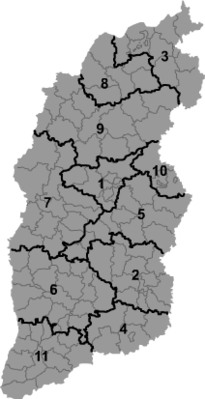
— Prefecture-level city — 1 Taiyuan 太原市 Tàiyuán Shì Xinghualing District 2 Changzhi 长治市 Chángzhì Shì Chengqu District 3 Datong 大同市 Dàtóng Shì Chengqu District 4 Jincheng 晋城市 Jìnchéng Shì Chengqu District 5 Jinzhong 晋中市 Jìnzhōng Shì Yuci District 6 Linfen 临汾市 Línfén Shì Yaodu District 7 Lüliang 吕梁市 Lǚliáng Shì Lishi District 8 Shuozhou 朔州市 Shuòzhōu Shì Shuocheng District 9 Xinzhou 忻州市 Xīnzhōu Shì Xinfu District, Xinzhou 10 Yangquan 阳泉市 Yángquán Shì Chengqu District 11 Yuncheng 运城市 Yùnchéng Shì Yanhu District The 11 prefecture-level divisions of Shanxi are subdivided into 119 county-level divisions (23 districts, 11 county-level cities, and 85 counties). Those are in turn divided into 1388 township-level divisions (561 towns, 634 townships, and 193 subdistricts).
See List of administrative divisions of Shanxi for a complete list of county-level divisions.
Politics
The Politics of Shanxi Province is structured in a dual party-government system like all other governing institutions in mainland China.[citation needed]
The Governor of Shanxi (山西省省长) is the highest ranking official in the People's Government of Shanxi. However, in the province's dual party-government governing system, the Governor has less power than the Shanxi Communist Party of China Provincial Committee Secretary (山西省委书记), colloquially termed the "Shanxi CPC Party Chief".
The province went through significant political instability since 2004, due largely to the number of scandals that have hit the province, mostly on labour safety. Yu Youjun and Meng Xuenong were top officials appointed by the central government to resolve sensitive issues as the province's party boss. However, the situation has, by and large, deteriorated during their tenures in office. As a result both Yu and Meng were forced to relocate themselves to relatively insignificant positions elsewhere in the country. In 2008 Shanxi's regional political problems were complicated by the death of Political Consultative Conference Chair Jin Yinhuan due to a car accident.
Economy
The GDP per capita of Shanxi is below national average. Compared to the provinces in East China, Shanxi is less developed for many reasons. Its geographic location limits it participation in international trade, which involves mostly eastern coastal provinces. Important crops in Shanxi include wheat, maize, millet, legumes, and potatoes. The local climate and dwindling water resources limits agriculture in Shanxi.[2]
Shanxi possesses 260 billion metric tons of known coal deposits, about one third of China's total. As a result, Shanxi is a leading producer of coal in China and has more coal companies than any other province,[3], with an annual production exceeding 300 million metric tonnes. The Datong (大同), Ningwu (宁武), Xishan (西山), Hedong (河东), Qinshui (沁水), and Huoxi (霍西) coalfields are some of the most important in Shanxi. Shanxi also contains about 500 million tonnes of bauxite deposits, about one third of total Chinese bauxite reserves.[4][5]
Industry in Shanxi is centered around heavy industries such as coal and chemical production, power generation, and metal refining.[citation needed] There are countless military-related industries in Shanxi Province due to its geographic location and history when it is used to be the base of the Chinese Communist Party and the People's Liberation Army. Taiyuan Satellite Launch Centre, one of China's three satellite launch centers, is located in the middle of Shanxi Province with China's largest stockpile of nuclear missiles.
Many private corporations joint with the state-owned mining corporations have invested billions of dollars in the Mining Industry of Shanxi Province. Hong Kong billionaire Li Ka-shing has made one of his largest investment ever in China on exploiting coal gas in Shanxi. Foreign investors include mining companies from Canada, the United States, Japan, the United Kingdom, Germany and Italy.[citation needed]
The mining related companies include Daqin Railway Co. Ltd., which runs one of the busiest and most technologically advanced railway in China connecting Datong and Qinhuangdao and exclusively for coal shipping.[citation needed] The revenue of Daqin Railway Co. Ltd. is among the highest in Shanxi Province's companies due to its exporting of coal to Japan, Korea, and South-East Asia.
Shanxi's nominal GDP in 2009 was 736.57 billion yuan (US$100 billion), ranked eighteenth in China. Its per-capita GDP was 21,544 yuan (US$3,154).[6]
Shanxi is infamous for bad working conditions in coal mining and other heavy industries. Thousands of workers have died every year in those industries. Cases of child labour abuse were discovered recently.[7][8]
In contrast with the poverty, Shanxi is known for its wealthy mine owners in China.[citation needed] Consortiums of mine owners from Shanxi have influences in Beijing's real estate market because of their speculation. The only other wealth group in China having the same influence is the entrepreneurs from Wenzhou, Zhejiang Province which is the centre of light industry of China and the world.[citation needed]
Industrial Zones
- Taiyuan Economic & Technology Development Zone
Taiyuan Economic & Technology Development Zone is a state-level development zone approved by State Council in 2001, with a planned area of 9.6 km². It is only 2 km away from Taiyuan Airport and 3 km away from railway station. The National Highway 208 and 307 passes through the zone. So far, it has formed a "four industrial base, a professional industry park" development pattern.[9]
- Taiyuan Hi-Tech Industrial Development Zone
Established in 1991, Taiyuan Hi-Tech Industrial Development Zone is the only state-level Hi-tech Development Zone in Shanxi Province, with total area of 24 km². It is situated close to Taiyuan Wusu Airport and Highway G208. The nearest port to the zone is Tianjin Port.[10]
Transportation
The transport infrastructure in Shanxi is very developed. There are many important national highways and railways that connect the province with neighboring provinces.[11]
Road
Shanxi's road hub is in the capital, Taiyuan. The major highways in province form a road network connecting all the counties. Examples of major highways are:
- Dayun Highway(大運公路)
- Datong-Yuncheng Highway (大同-運城))
- Taiyuan-Jiuguan Expressway (太原-舊關高速公路)
- Beijing-Shijiazhuang expressway (北京-石家庄高速公路)
- Beijing-Tianjin-Tanggu expressway (京津唐高速公路)
- Beijing-Shenzhen expressway
Rail
Shanxi has extensive rail infrastructure to neighboring provinces. The rail network connects to major cities Taiyuan, Shijiazhuang, Beijing, Yuanping, Baotou, Datong, Menyuan and Jiaozuo. The province also have extensive rail network to coastal cities such as Qinghuandao, Qingdao, Yantai and Lianyungang.[11]
The province has a rail network called the Shuozhou-Huanghua Railway. It will service Shenchi county in Shanxi with Huanghua port in Hebei. It will become the second largest railway for coal transport from west to east in China.[12]
Aviation
Shanxi's main aviation transport hub is Taiyuan Wusu Airport (IATA: TYN). The airport has routes connecting Shanxi to 28 domestic cities including Beijing, Xi'an, Chengdu and Chongqing. There are international routes to Hong Kong, Singapore, Japan and Russia. There is also another airport in Datong, which has domestic routes to other mainland cities.[11][13]
Demographics
The population is mostly Han Chinese with minorities of Mongol, Manchu, and Hui.
Ethnic groups in Shanxi, 2000 census Nationality Population Percentage Han Chinese 32,368,083 99.68% Hui 61,690 0.19% Manchu 13,665 0.042% Mongol 9,446 0.029% Source: Department of Population, Social, Science and Technology Statistics of the National Bureau of Statistics of China (国家统计局人口和社会科技统计司) and Department of Economic Development of the State Ethnic Affairs Commission of China (国家民族事务委员会经济发展司), eds. Tabulation on Nationalities of 2000 Population Census of China (《2000年人口普查中国民族人口资料》). 2 vols. Beijing: Nationalities Publishing House (民族出版社), 2003. (ISBN 7-105-05425-5)
In 2004, the birth rate was 12.36 births/1000 population, while the death rate was 6.11 deaths/1000 population. The sex ratio was 105.5 males/100 females. [3]
Health
In the 2000s, the province was considered to be one of the most polluted areas in China.[14] The pollution, caused in part by heavy coal mining, has enhanced health problems in the province.[15]
Culture
People in most regions of Shanxi speak dialects of Jin, a subdivision of spoken Chinese. However, dialects in the southwest, near the border with Henan and Shaanxi, are classified as part of the Zhongyuan Mandarin subdivision of the Mandarin group rather than Jin. In terms of characteristics, Jin dialects are generally distinguished by their retention of the entering tone from Middle Chinese. In this respect they are unique in all of northern China, as most of the surrounding Mandarin dialects (spoken over the remainder of northern China) have lost it. (In central and southern China, it is much more common for the entering tone to be kept.) Jin is also noted for extremely complex tone sandhi systems.
Shanxi cuisine is most well known for its extensive use of vinegar as a condiment and for its noodles. A dish originating from Taiyuan, the provincial capital, is the Taiyuan Tounao (太原头脑, literally "Taiyuan Head"). It is a soup brewed using mutton, shanyao (山药, Chinese wild yam), lotus roots, astragalus membranaceus (黄芪, membranous milk vetch), tuber onions, as well as cooking liquor for additional aroma. It can be enjoyed by dipping pieces of unleavened cake into the soup, and is reputed to have medicinal properties.
Shanxi Opera (晋剧 Jinju) is a popular form of Chinese opera in Shanxi. It was popularized during the late Qing Dynasty, with the help of the then-ubiquitous Shanxi merchants who were active across parts of China. Also called Zhonglu Bangzi (中路梆子), it is a type of bangzi opera (梆子), a group of operas generally distinguished by their use of wooden clappers for rhythm and by a more energetic singing style; Shanxi opera is also complemented by quzi (曲子), a blanket term for more melodic styles from further south. Puzhou Opera (蒲剧 Puju), from southern Shanxi, is a more ancient type of bangzi that makes use of very wide linear intervals.
Shanxi merchants (晋商 Jinshang) constituted a historical phenomenon that lasted for centuries from the Song to the Qing Dynasty. Shanxi merchants ranged far and wide from Central Asia to the coast of eastern China; by the Qing Dynasty they were conducting trade across both sides of the Great Wall. During the late Qing Dynasty, a new development occurred: the creation of piaohao (票号), which were essentially banks that provided services like money transfers and transactions, deposits, and loans. After the establishment of the first piaohao in Pingyao, the bankers in Shanxi dominated China's financial market for centuries until the collapse of Qing Dynasty and the coming of British banks.
Tourism
- Jinci in Taiyuan, famous for its temples and Song Dynasty paintings and architectures.
- Zuoquan County, famous for its China Communist Party battlefield sites.
- The Ancient City of Pingyao is a World Heritage Site near Taiyuan. Once a great financial center of China, it is noted for its preservation of many features of northern Han Chinese culture, architecture, and way of life during the Ming and Qing Dynasties.
- The Yungang Grottoes, its literal translation being The Cloud Ridge Caves, are shallow caves near Datong. There are over 50,000 carved images and statues of Buddhas and Boddhisatvas within these grottoes, ranging from 4 centimeters to 7 meters tall.a World Heritage Site in Datong, consist of 252 caves noted for their collection of 5th and 6th century Buddhist grotto sculptures and reliefs.
- Mount Wutai (Wutai Shan) is the highest point in the province. It is known as the residence of the bodhisattva Manjusri, and as a result is also a major Buddhist pilgrimage destination, with many temples and natural sights. Points of interest include Tang Dynasty (618–907) era timber halls located at Nanchan Temple and Foguang Temple, as well as a giant white stupa at Tayuan Temple built during the Ming Dynasty (1368–1644).
- Mount Hengshan (Heng Shan), in Hunyuan County, is one of the "Five Great Peaks" of China, and is also a major Taoist site. Not far from Heng Shan, the Hanging Temple is located on the side of a cliff and has survived for 1400 years despite earthquakes in the area.
- Pagoda of Fogong Temple, in Ying County, is a pagoda built in 1056 during the Liao Dynasty. It is octagonal with nine levels (five are visible from outside), and at 67 m (220 ft) in height, it is currently the tallest wooden pagoda in the world. It is also the oldest fully wooden pagoda in China, although many no-longer-existing wooden pagodas have preceded it, and many existing stone and brick pagodas predate it by centuries.
- Hukou Waterfall is located in the Yellow River on the Shanxi-Shaanxi border. At 50 meters high it is the second highest waterfall in China.
- Dazhai is a village in Xiyang County. Situated in hilly, difficult terrain, it was a holy site during the Cultural Revolution, when it was set out to the entire nation as exemplary of the hardiness of the proletariat, especially peasants.
Education
See also: List of universities and colleges in ShanxiMajor Post-Secondary institutes in Shanxi include:
- Changzhi College (长治学院)
- Changzhi Medical College (长治医学院)
- Datong University (山西大同大学)
- Jinzhong College (晋中学院)
- Lvliang Higher College
- North China University of Science and Technology (华北工学院)
- Shanxi Agricultural University (山西农业大学)
- Shanxi College of Traditional Chinese Medicine (山西中医学院)
- Shanxi Medical University (山西医科大学)
- Shanxi Teachers University also called Shanxi Normal University (山西师范大学)
- Shanxi University (山西大学)
- Shanxi University of Finance and Economics (山西财经大学)
- North China University (中北大学)
- Taiyuan Normal University (太原师范学院)
- Taiyuan University of Science and Technology (太原科技大学)
- Taiyuan University of Technology (太原理工大学)
- Xinzhou Teachers University (忻州师范学院)
- Yuncheng University (运城学院)
Major Secondary Schools in Shanxi include:
- Taiyuan No.5 High school
- Taiyuan No.10 High school
- Shanxi Experimental Secondary School(山西省实验中学)
References
- ^ (Chinese) Origin of the Names of China's Provinces, People's Daily Online.
- ^ [1]
- ^ http://thechinaperspective.com/topics/province/shanxi-province/
- ^ http://www.chinamining.org/Facts/2006-09-29/1159510064d1417.html
- ^ http://www.hktdc.com/info/mi/a/mpcn/en/1X06B4AE/1/Profiles-Of-China-Provinces-Cities-And-Industrial-Parks/Yangquan-Shanxi-City-Information.htm
- ^ http://www.sx.chinanews.com/news/2010/0316/19214.html
- ^ "Chinese mine blast toll doubles". BBC News. 2009-11-22. http://news.bbc.co.uk/2/hi/asia-pacific/8372760.stm. Retrieved 2010-05-23.
- ^ http://www.clb.org.hk/en/node/35712
- ^ RightSite.asia | Taiyuan Economic & Technology Development Zone
- ^ RightSite.asia | Taiyuan Hi-Tech Industrial Development Zone
- ^ a b c http://www.accci.com.au/keycity/shanxi.htm
- ^ http://www.sz.sxei.cn/szszsj/tzhj/tzhj_1.htm
- ^ http://www.travelchinaguide.com/cityguides/shanxi/datong/transportation/
- ^ http://thechinaperspective.com/topics/province/shanxi-province/
- ^ Disabilities in China's polluted Shanxi, 2009
External links
- Shanxi Government website
- Shanxi travel guide from Wikitravel
- Shanxi Community in Canada website
- Shanxi Community in Japan website

Inner Mongolia 
Shaanxi 
Hebei  Shanxi
Shanxi 

Henan Shanxi topics General Geography Cities • Taihang Mountains • Lüliang Mountains • Yellow River • Fen River • Mount Wutai • Mount Hua • Great Wall of China • Xiechi LakeEducation Culture Visitor attractions Shanxi Province county-level divisions Taiyuan: Xinghualing District · Xiaodian District · Yingze District · Jiancaoping District · Wanbailin District · Jinyuan District · Gujiao City · Qingxu County · Yangqu County · Loufan County
Datong: Chengqu District · Kuangqu District · Nanjiao District · Xinrong District · Yanggao County · Tianzhen County · Guangling County · Lingqiu County · Hunyuan County · Zuoyun County · Datong County
Yangquan: Chengqu District · Kuangqu District · Jiaoqu District · Pingding County · Yu County
Changzhi: Chengqu District · Jiaoqu District · Lucheng City · Changzhi County · Xiangyuan County · Tunliu County · Pingshun County · Licheng County · Huguan County · Zhangzi County · Wuxiang County · Qin County · Qinyuan County
Jincheng: Chengqu District · Gaoping City · Zezhou County · Qinshui County · Yangcheng County · Lingchuan County
Shuozhou: Shuocheng District · Pinglu District · Shanyin County · Ying County · Youyu County · Huairen County
Jinzhong: Yuci District · Jiexiu City · Yushe County · Zuoquan County · Heshun County · Xiyang County · Shouyang County · Taigu County · Qi County · Pingyao County · Lingshi County
Yuncheng: Yanhu District · Yongji City · Hejin City · Ruicheng County · Linyi County · Wanrong County · Xinjiang County · Jishan County · Wenxi County · Xia County · Jiang County · Pinglu County · Yuanqu County
Xinzhou: Xinfu District · Yuanping City · Dingxiang County · Wutai County · Dai County · Fanshi County · Ningwu County · Jingle County · Shenchi County · Wuzhai County · Kelan County · Hequ County · Baode County · Pianguan County
Linfen: Yaodu District · Houma City · Huozhou City · Quwo County · Yicheng County · Xiangfen County · Hongdong County · Gu County · Anze County · Fushan County · Ji County · Xiangning County · Pu County · Daning County · Yonghe County · Xi County · Fenxi County
Lüliang: Lishi District · Xiaoyi City · Fenyang City · Wenshui County · Zhongyang County · Xing County · Lin County · Fangshan County · Liulin County · Lan County · Jiaokou County · Jiaocheng County · Shilou CountyProvincial level divisions of the People's Republic of China Provinces 
Autonomous regions Municipalities Special Administrative Regions Territorial disputes - Paracel, Spratly, Zhongsha Islands (see Paracels, Spratlys, & Zhongsha Iss. Authority)
- Pratas Islands
- Senkaku Islands
- South Tibet
- Taiwan, Kinmen & Matsu (see Legal status of Taiwan)
Wikimedia Foundation. 2010.

